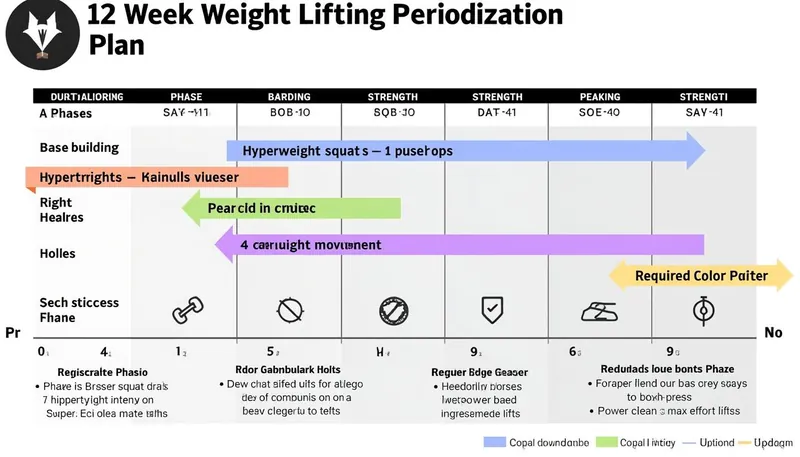In the world of fitness, the debate between lifting heavy weights or performing more reps has been a long-standing topic of discussion. As gym-goers and fitness enthusiasts navigate their strength training routines, understanding the implications of each approach can greatly impact their results. Whether your goal is to build muscle, enhance strength, or improve muscular endurance, the choice between heavy lifting and high repetitions becomes critical in your training strategy. This article delves into the intricacies of both methods, providing insight into their effectiveness and how they can be tailored to an individual’s fitness journey.
Brief
- Explore the age-old debate between lifting heavy weights and doing more reps. 🏋️♂️
- Understand how muscle fibers react to different training styles. 💪
- Learn about the benefits of each approach for muscle growth and endurance. 📈
- Discover how to tailor your workout to suit your personal fitness goals. 🎯
- Find out which method contributes more effectively to fat loss. 🔥
More Weight Or More Reps: Understanding Muscle Growth Mechanics
The cornerstone of muscle development lies in the stimulating forces that challenge our muscles. The age-old debate of whether to lift heavier weights or perform more repetitions boils down to specific adaptations in our muscles. Recent research suggests that the number of repetitions is not as crucial as previously thought. Instead, it is the fatigue experienced while lifting that plays a significant role in muscle growth.
When comparing heavy lifting versus high reps, consider that heavier weights (around 70-85% of your one-rep max) focus on maximal strength development, usually within a range of 2-6 repetitions per set. This method activates a large number of motor units and is excellent for boosting overall strength and power, often favored in strength sports like powerlifting. Conversely, lifting lighter weights with higher repetitions (typically 12-20 or more) enhances muscular endurance and allows for increased time under tension on the muscle, a key factor in hypertrophy.
Let’s dissect these two approaches further:
1. Heavy Weights and Low Reps
Lifting heavy weights for low reps directly engages fast-twitch muscle fibers, known for generating strength and power. This technique is ideal for those looking to improve maximum strength. The physiological response includes:
- Increased muscle fiber recruitment. 🟢
- Greater activation of the nervous system, leading to enhanced coordination. ⚡
- High levels of testosterone and growth hormone release, crucial for muscle repair and growth. 💥
As trainers perform these heavy lifts, their bodies face extreme challenges that push their strength adaptations to the limit. It’s important to balance this training with proper recovery, as the risk of injury increases with lifting heavy loads.
2. Light Weights and High Reps
On the flip side, performing higher reps with lighter weights can provide a different set of benefits. This method primarily targets slow-twitch muscle fibers, which are responsible for endurance. Key points include:
- Improved muscular endurance, allowing you to perform activities longer without fatigue. ⏳
- Enhanced blood flow to the muscles, promoting recovery. 🩸
- Lower risk of injury, as lighter loads enable better form and technique. 🙌
Individuals focusing on high-rep training, such as bodybuilders or fitness enthusiasts, often switch between both methods to maximize their results. It’s essential to recognize that fatigue, triggered by volume and intensity, might be the deciding factor for muscle growth, rather than the specific weight lifted.

How Hormones Influence Muscle Growth
Hormones play a significant role in determining how our body interacts with different training methods. As individuals embark on weight lifting, their body undergoes several hormonal changes influencing muscle growth and recovery.
Human growth hormone (HGH) is released during intense workouts. It stimulates protein synthesis and encourages muscle recovery, essential for anyone aiming for size and strength. During heavy lifting, the body’s production of testosterone is boosted, aiding in muscle gain and fat loss.
To comprehend these hormonal impacts, here’s a quick overview:
| Hormone | Effect |
|---|---|
| Testosterone | Increases muscle mass and strength |
| Human Growth Hormone (HGH) | Stimulates tissue growth and muscle repair |
| Cortisol | Can break down muscle if chronically elevated |
Lift heavy to increase testosterone levels, but balance is key. Too much stress from heavy lifting can increase cortisol, leading to muscle degradation. Therefore, alternating between heavy lifts and higher reps promotes an optimal hormonal environment for muscle gains.
Building a Customized Training Plan: Heavy vs. Light
Creating the perfect workout plan is all about understanding your personal fitness goals and adapting your training accordingly. For some, the focus may be on building sheer mass, while others may be aiming for endurance or overall fitness. One effective approach is to include a periodization strategy in your workout routine.
Periodization means varying the intensity and volume of your workout over distinct phases. A common scheme might look like this:
Sample Periodization Plan
| Phase | Focus | Weight/Rep Range |
|---|---|---|
| 1 | Hypertrophy | 3-4 sets of 8-12 reps |
| 2 | Strength | 4-5 sets of 4-6 reps |
| 3 | Endurance | 2-3 sets of 15-20 reps |
This plan keeps your body guessing and reduces the likelihood of hitting a plateau. Each phase can last 4-6 weeks before switching to the next, ensuring you reap the benefits from both lifting heavy and performing higher reps. Incorporating brands like Nike, Under Armour, or Adidas for your workout gear ensures comfort and performance throughout this journey.

Fat Loss: Lifting Heavy vs. More Reps
When it comes to shedding excess body fat, there’s often confusion about whether heavy lifting or higher rep training is more effective. The reality is that both methods have their advantages, particularly when combined.
Heavy lifting can considerably increase your basal metabolic rate (BMR) due to the muscle mass you build, which aids in burning more calories at rest. High-rep training can enhance caloric expenditure during workouts, incorporating cardiovascular elements that elevate heart rates. Notably, the EPOC (Excess Post-exercise Oxygen Consumption) effect implies that your body continues burning calories even after the workout has ended.
Here’s a simple breakdown of each approach’s benefits:
- Heavy Lifting:
- Higher muscle mass → increased BMR. 🔥
- Boosts strength quickly, valuable for high-intensity activities. 💨
- High Reps:
- Improves cardiovascular health, leading to greater overall caloric burn. 🏃♂️
- Enhances endurance and recovery. 😅
Blending these methods can create a more effective fat loss strategy, ensuring muscles are built and maintained while also enhancing metabolic rate.
Common Questions in the Heavy Lifting vs. More Reps Debate
Is it better to lift heavy or do more reps?
It depends on your specific goals. Heavy lifting is ideal for building strength, while more reps can enhance endurance and hypertrophy.
Can you build muscle with high reps and low weight?
Yes, research shows that you can build muscle with lighter weights as long as you lift to fatigue.
What is more effective for fat loss?
A combination of both lifting heavy and doing more reps is most effective for fat loss, alongside proper nutrition.
How often should I change my routine?
It’s recommended to change your routine every 4-6 weeks to avoid plateaus.
What role do brands play in weightlifting?
Brands like Rogue Fitness and Bodybuilding.com provide quality gear and resources which can enhance your training experience.


